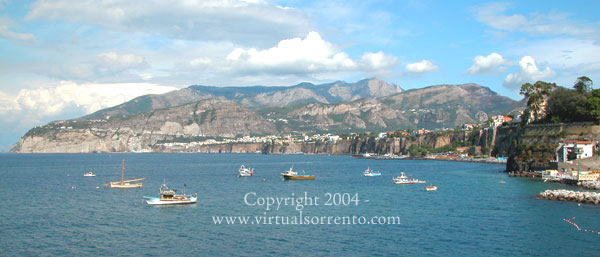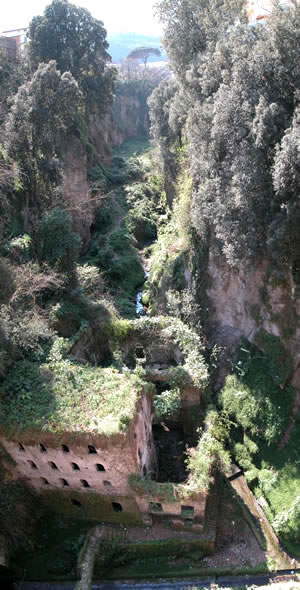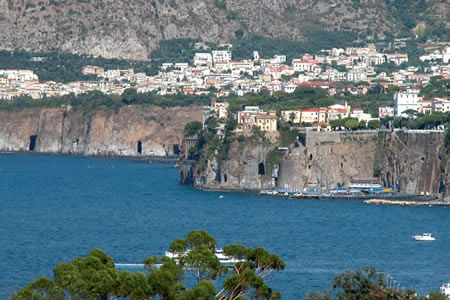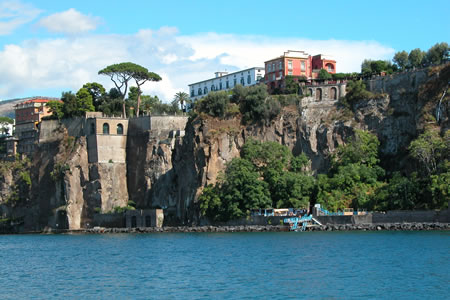Brief geological history of the Sorrentine Peninsula
by Salvatore Palomba
- Part III -
In the Quaternary period (the last 2 million years) the final hundred thousand years will be fundamental in determining the current configuration of the Sorrentine Peninsula, particularly with regard to the Sorrento Plain on which the main towns have developed (Meta, Piano di Sorrento, Sant’Agnello and Sorrento).
In fact, crust movements in the Pliocene and Quaternary periods produced deep fractures in the Earth’s crust with the formation, especially along the Tyrrhenian coast, of numerous volcanic structures.
The Campania volcanic region is one of the most significant as still today it boasts important active volcanoes (Vesuvius and the Phlegrean Fields).
The Sorrentine Peninsula is not a volcanic area but, given its position only tens of kilometres from eruption centres, has in any event suffered both in seismic terms and eruption debris deposits.

Sorrentine Peninsula geography, in fact, changed considerably after the deposit of volcanic sediments, particularly of Campanian Grey Tufa stone which, ‘trapped’ in a pre-existing basin, formed the Sorrento Plain, surrounded by hills on three sides and boundaried by the sea to the north. From both a landscape and anthropological viewpoint, this is the most typical and characteristic aspect of the Sorrentine Peninsula.
 In fact, the typical coastal cliffs and the deep gorges cut into the
tufa (which as the results of modern presumption of man have been partly
filled with waste in order to build, in most cases, roads and squares)
are the result of exogenous agent action on the tufa formation.
In fact, the typical coastal cliffs and the deep gorges cut into the
tufa (which as the results of modern presumption of man have been partly
filled with waste in order to build, in most cases, roads and squares)
are the result of exogenous agent action on the tufa formation.
The most recent surveys agree that grey tufa is the product of an enormous explosive eruption of a volcanic structure, the forebear of the Phlegrean Fields volcanoes known as "Archiphlegrean” which with this eruption ceased its activity, the explosion causing the destruction and collapse of the central section of the structure forming the "Archiphlegrean Caldera” in which the more recent Phlegrean volcanoes developed.
The grey tufa was laid in the form of a high temperature “ignimbrite cloud” with high gas content; this probably represents the result of more than one explosion stage in which enormous quantities of ashes and laval debris were deposited in a random manner and later lapidified, cooling more or less slowly so that the deeper sections currently have a lithoid consistency while the most superficial are semi-compact and particularly sensitive to erosion by exogenous agents.
It is no mere chance that, along the cliff coasts, the lower part of the wall is always fairly compact whereas the upper part is characterised by typical aeolic erosion formations.


Grey tufa filled the depressions across the entire Campania basin and spreads from the Caserta to Agro Nocerino-Sarnese areas; on the Sorrento Plain, however, it has contributed to the creation of a particular landscape characterised by a high cliff coast. Over the years this has progressively retreated as a result of undermining at the base by wave movement and subsequent collapse of the tufa blocks which, following erosion, led to the formation of small beaches with black sand in the inlets, often at the mouth of streams which cut the tufa plain perpendicular to the sea.
To conclude this brief and certainly incomplete geological history of the Sorrentine Peninsula, it can be confirmed that it is strictly related to events leading to the formation of the Campano-Lucano section of the Apennines, of which the Peninsula represents the westernmost ramification.
The bedrock is composed of carbonate rocks (limestone and dolomitic limestone) with areas rich in Late Cretaceous fossils. Above this are sediments from the Miocene period, composed of sandstones and clays which, in the upper section include allochthonous rock (from sedimentation basins other than that in which the Miocene rock was deposited) laid following the vast tectonic movements leading to formation of the Apennine Chain.
Covering the above mentioned rock we find pyroclastic sediments linked to explosive phases from numerous volcanoes in the Naples area which, paedogenized, i.e. enriched with organic substances, represent the soil strata.
